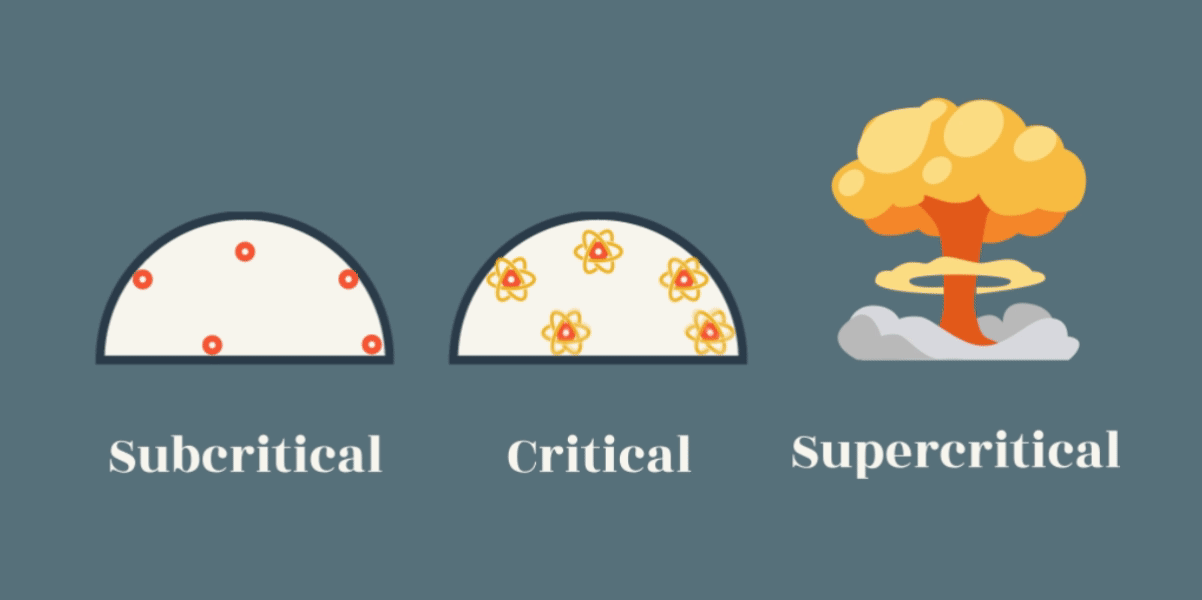Chain reaction content — does your website have enough?
Ian Duncan • 24th Apr 2024

In a nuclear reaction, when you collect enough fissionable materials together they have special properties that cause a self-sustaining chain reaction.
On a web page, something similar happens when you collect enough of the right kind of information — we call it chain reaction content — because it causes a chain reaction in the mind of the customer that ends with them buying or enquiring.
A chain reaction becomes self-sustaining when you reach something called critical mass. The goal for a web page is to find enough of the right information. So how do we reach critical information mass? And what special properties are we looking for in that content?
While you can treat your website like a physics lab (and there’s plenty of analytics and testing tools to help with that), the one variable you can’t control is your website visitor. Specifically we can’t know exactly what your potential customer does or does not already know. Think of your content proposition like a jigsaw — your customer has some of the pieces already (probably), but you don’t know which ones. It’s your job to make sure they can complete the picture by providing enough of the right kind of information.
Subcritical, critical and supercritical
A nuclear reaction can be in one of three states:
- Subcritical — where the mass of fissile material is not enough to sustain the reaction
- Critical — where there is just enough mass for a controlled self-sustaining reaction (we use that for nuclear energy)
- Supercritical — where there is more than enough material and the chain reaction is rapid and uncontrolled (that’s… an explosion)

While going supercritical in a nuclear context is very bad news, it should be the aim for your website.
You want enough chain reaction content to explosively propel your website visitors to take action. Supercritical means you have more than enough chain reaction content to get users buying/enquiring.
Finding chain reaction content
It’s not enough to collect any old information and add it to a page. Chain reaction content has special properties — it propels people to take action by directly addressing any potential user anxiety regarding your product or service. The good news is chain reaction content is already pinging around your organisation, waiting to be collected.
The sales (or customer-facing) team information goldmine
Want to know what’s bugging your customers? Speak to the front-line sales teams and the support staff that field customer queries. Customer-facing people are a goldmine of information; over time they naturally collect queries and objections from customers, and they have to find solutions to these.
There’s a very good chance that large chunks of that information fit the chain reaction content bill. That means it should be on your website. There’s also a good chance some of that information isn’t.
Don’t have a sales team? Well if you’ve ever answered a question posed by a prospective customer then the information is likely in your head.
Surveys
You can, and should, survey your customers to understand what makes them tick. Speak to them in person or use your website. Online survey tools make it easy to gather Voice of Customer (VoC) data quickly and it’s easy to set up surveys for pre- and post-enquiry or purchase, as well as exit surveys.
If you have an email list, this is also fertile territory to recruit survey participants.
If you’re not sure if the information you’ve collected is capable of causing the chain reaction we want, here’s a good question to use as a litmus test:
Does this information provide a compelling answer to a customer objection? (Where ‘objection’ is a broad catch-all for any barrier stopping a customer from buying.)
Think of every website visitor as having a unique set of objections waiting for the right product or service to dissolve those objections, and with that dissolve any doubts preventing them from parting with their (or their company’s) hard earned cash.
Over time, your website will need to answer every possible variation of objections, which means it needs to be equipped with every piece of the jigsaw.
Work with the data from your sales teams and surveys and you won’t be stabbing in the dark; you’ll be pushing on an open door that leads to higher conversions for your site.
A critical mass for action — how much is ‘enough’?
Venerated copywriter Claude Hopkins said of adverts: “The only readers we get are people whom our subject interests. No one reads ads for amusement, long or short. Consider them as prospects standing before you, seeking for information. Give them enough to get action.”
“Enough” information depends on the product and the customer.
If your product has lots of features and benefits, or requires a lot of explanation to persuade a customer to buy, then it makes sense to equip your webpage with a suitably comprehensive armoury — in words and images — to match the approach you would take in person. Your copy needs enough breathing room to cover every point in enough detail to get action.
On the other hand, if your product or service is well-known, then a lot of the groundwork in the sale already exists in the mind of the prospect. It may make sense to keep your page focused on the additional points of information they need to tip them over the edge from prospect to buyer. We’d still argue all the pieces of the jigsaw need to be there, but the design can prioritise those additional points of information.
How many minutes would you take to sell this product/service in person?
Try recording yourself selling the product or service in person, and see how many minutes you need to do it justice. Now consider the usual questions you get asked and add on how long it takes you to answer those.
If it takes you 10 minutes of sales chat to sell a thing in person, and particularly if you also have a physical product you can show off, then it stands to reason you need at least as many words on a webpage to do the same sales job online.
Don’t confuse brevity with clarity on the web
There’s a popular misconception that shorter webpages are somehow better. There may be instances where that’s true (think highly visual products, where the ‘look’ is the most important feature), but it’s a seductive trap to confuse brevity with clarity on the web.
Remember it’s not possible to know the inner thoughts of your reader, or what “enough” information looks like for them (but remember you can always ask them this in a survey or live chat). You need to cover all the bases. By definition that means more content.
Sometimes that content will be words, sometimes images, but the underlying point is this: if it’s chain reaction content, it’s almost impossible to have too much.
As the famous phrase goes: “things should be as simple as possible, but no simpler”. In a web page context it’s a damaging oversimplification to omit detail in the pursuit of brevity. Some users may be looking for that information. In doing so you sacrifice clarity around the whole. An information void opens up and that translates into user anxiety.
So if there’s lots of points to cover then a short webpage makes zero sense — you are literally limiting your ability to sell the product with an artificial constraint. You are also working against the medium you’re designing in — a webpage — which is set up for infinite vertical scrolling, not to mention hampering your ability to rank well in search engines.
Enough said
Direct marketers, some of the best copywriters, have known for years that long-form copy sells. They research the people they are addressing as much as the features, advantages and benefits they are selling. They make sure there is enough information — a critical mass of chain reaction content — to get action.
So the next time you find yourself considering a webpage design and wondering if there’s too much text, try asking yourself the opposite question. Does it have enough?


